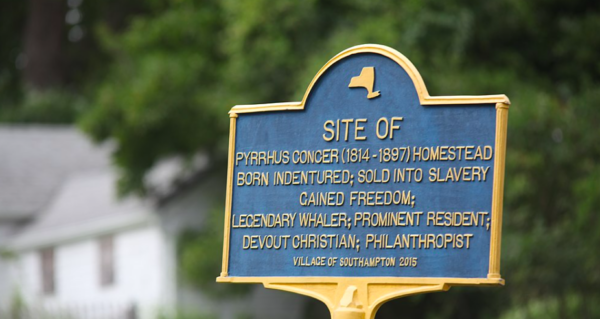An almost decade-long fight to preserve African-American history in New York’s hideaway for the rich and famous is underway, centering itself on the life of a Black whaler and philanthropist from the 19th century named Pyrrhus Concer. He was one of the first Westerners to visit Japan. However, some are pushing back, saying while the businessman is worthy of celebration, the land in dispute is not.

Now, after new records and archeological evidence prove a small property in Sag Harbor is not only from the 1800s but also was the residence of none other than Concer, it will be restored, The New York Times reports.
The Hamptons’ Multicultural History
The Hamptons are often seen as a vacation spot for the nation’s most wealthy to entertain. But the area contains a rich and multicultural history. In addition to the 750-acre reservation hosting about 1,300 members of the Shinnecock nation, an indigenous group with stakes on the land that predate the arrival of Europeans more than four centuries ago, it also has a legacy of African-Americans, many formerly enslaved, that made a living on the northernmost coast of Long Island as sea workers.
According to The New York Times, the African-American presence was significant in Southampton since well before the end of slavery in the state of New York in 1827. The Long Island area was the location for churches like St. David African Methodist Episcopal Zion Church in Sag Harbor, a space local lore says was a stop on the Underground Railroad.
By the early 1900s, Sag Harbor started to welcome professional Blacks, including doctors and lawyers, who purchased land as a way to participate in the American dream. After World War II, three towns, Azurest, Ninevah, and Sag Harbor Hills, became the anchor for many African-Americans who opted to either buy vacation homes there or live there year-round.
Now, the area has become an oasis for the rich and famous, with celebrities and influencers like Russell Simmons, Sean “P. Diddy” Comb, and more renting our homes to entertain their friends.
With the transitions of many older socialites like B. Smith, and Harold & Myrtle Hamilton, the complexion of Sag Harbor is changing.
In 2022, the Black population seems to be dwindling with the largest Southampton racial/ethnic groups being white (70.5 percent). The second largest is Hispanics at 19.7 percent, according to New York Demographics, and Blacks make up less than 6 percent.
Specifically, in Sag Harbor, Blacks make up 2.5 percent, while whites are 92.24 percent of the current population, the census records.
Concer was one of those Black New Yorkers with a history that stretches back centuries.
Born in 1814 in Southampton to his enslaved mother Violet, he gained his freedom through New York state’s legal process known as Gradual Emancipation. As a freedman, he engaged in various whaling voyages captained by local families, the Southampton African American Museum records.
Concer made his fortune and gained acclaim in this space.
“After working as a farm hand, Concer shipped out on a whaling vessel, like many young Long Island men,” the museum documents state. “He advanced from a green hand in 1832 to pilot, eleven years later, of the whaleship Manhattan. In 1845, he had his most notable maritime adventure when he and his shipmates rescued some shipwrecked Japanese sailors. The Manhattan, with Concer aboard, delivered the Japanese sailors back to their native land–then a closed society. By spending long periods working at sea, Concer was able to improve his economic situation back home.”
How Concer Got the Property
His newly freed grandparents had acquired land after achieving their freedom. The lot where they live is now the property in question, 51 Pond Lane. Town records show in 1838, Concer bought an acre from his grandparents to the west of their lot.
Five years later, in 1843, when his grandmother had become aged and widowed, she granted her property and home to Concer as payment for him taking care of her at the end of her life.
Despite what some considered the home’s historical significance, it was demolished by private entities to build a two-story house and pool in 2014.
The Question of Historical
Paul Chiarani, 78, lived in the home from 1986 to 2013, when he sold it to his neighbors. Although he knew of the story of Concer, he didn’t believe the home was that of the deceased whaler.
“There was nothing historical about that house,” said Chiarani, who once tried to tear the property down in 2012 but was denied a permit to do so because the home was within the Southampton Village Historic District.
But the house turned out not to be historical. “Due to lack of architectural or historical integrity, a demolition permit may be granted for this property,” stated Zachary Studenroth, a consultant for the village, who evaluated the property for historic designation eligible. In his review, he noted there was only one piece of the house that was from before the 20th century, the estate’s cement block foundation.
Chiarani sold the property to his neighbors, David Hermer, managing director in the investment banking division at Credit Suisse, and Silvia Campo, in July 2013 for $2.75 million.
A New Fight Over the House
When Hermer and Campo went to apply for a permit, the application landed in front of longtime Southampton resident Brenda Simmons, the founder and executive director of the Southampton African American Museum, and at the time the assistant to the village mayor.
Simmons was immediately outraged at the couple’s request.
“She came in yelling at me, ‘You can’t do this!’ I had no idea what she was talking about,” former Mayor Mark Epley told The New York Times.
A new evaluation was launched, and it was determined that Concer had lived in the home.
Lasting Records
Because of slavery, there are very few African-Americans that have a documented history beyond the late 1800s and early 1900s. But that is not the case for Concer. His extraordinary life was well documented.
The 1850 federal census lists him as a head of household living in the area of what is now 51 Pond Lane. Researchers also found land records, photographic evidence, and documents that suggest Concer and his wife, Rachel, lived for decades with his grandparents.
What has also been discovered was that in 1891, Concer “pursued litigation to protect his homestead. Not only did he deeply value and carefully manage his real estate holdings, he ensured his personal sovereignty and full rightful status as a landowner.”
The whaler died in 1897. His wife and two children died before him, leaving him no blood heirs. Upon his death, he left most of his savings to charitable causes, including funds to support and educate children at his house of worship, the First Presbyterian Church.
With the new information, the group helped the property become qualified for protection under the village landmark criterion for a structure “identified with historic personages.”
One of the most prestigious nods to the estate came from United States Secretary of State (under President Theodore Roosevelt’s administration) Elihu Root who also was Concer’s neighbor. After Concer’s death, Root bought the property at 51 Pond Lane from the executor of Concer’s estate. The Nobel Peace Prize winner wrote the inscription now on Concer’s tombstone: “Though born a slave, he possessed those virtues, without which kings are but slaves.”
Victory Despite Expensive Battles
In 2013, after the permit was denied, Hermer and Campo filed a $10 million lawsuit against the village. They claimed the village government was essentially seizing their property reliant only on the architectural review board that had no jurisdiction over building interiors and the decision for them to build their home.
The mayor settled their lawsuit in 2014. The architectural review board approved the demolition in exchange for the couple to allow them to gather historical material from the structure.
During the demolition, more archeological artifacts were discovered, including the white oak sill of the house, chopped with an ax. “You don’t find these things in 20th-century homes,” Robert Strada, a specialist in architectural preservation and restoration projects, said.
Amidst all of the controversy and after tearing down the home, the couple abandoned their plans to rebuild. Instead, they put the land on the market and asked the village to refund $18,750 they exhausted in new-construction fees. The village agreed to pay that fee in 2015, using money from its Community Preservation Fund (CPF), created to protect and restore the site in partnership with the Village of Southampton.
The Town of Southampton bought the property for $4.3 million.
In 2021, the plot was designated a landmark of Southampton Village, and the Pyrrhus Concer Action Committee submitted its application and requests for variances.
Now, Concer’s home is on its way to being rebuilt.




